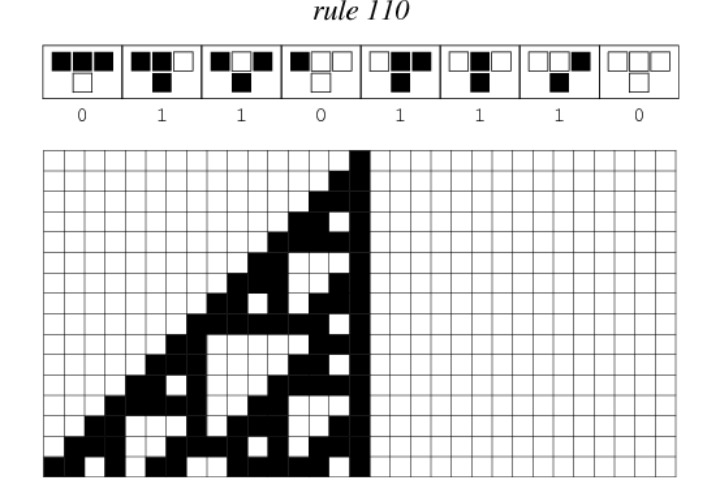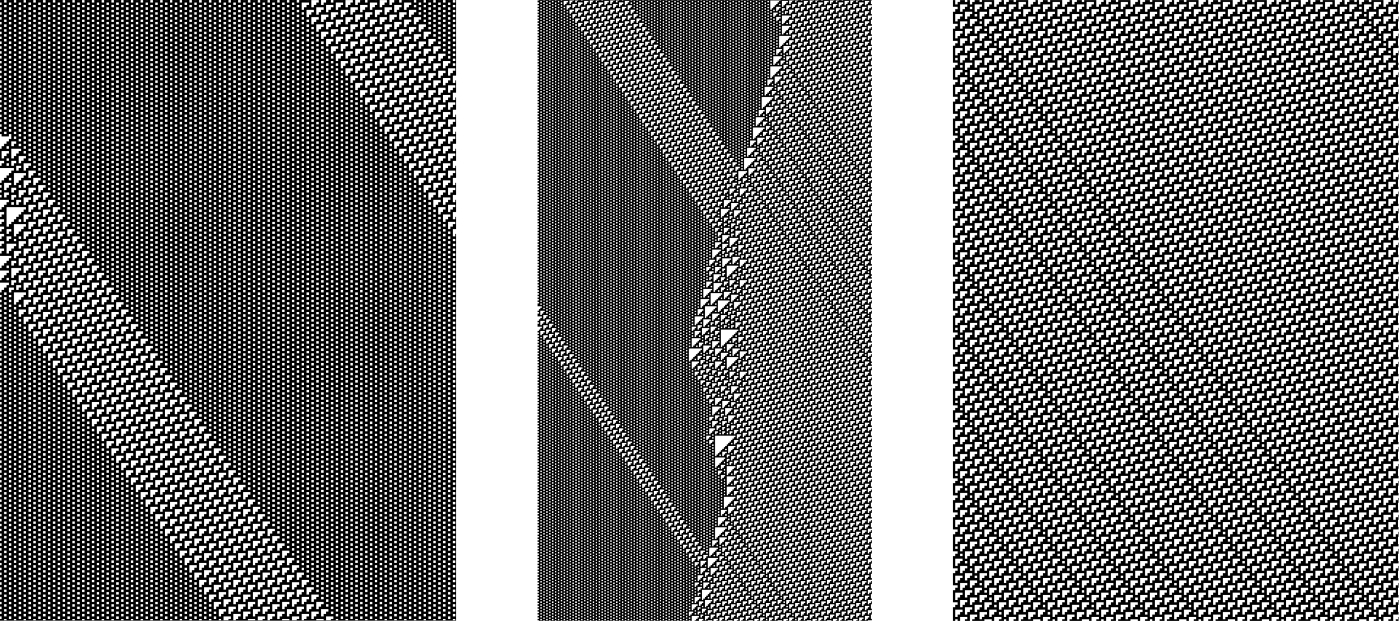Emergence: combining cellular automata with live data
Joseph Rodrigues Marsh, Gaytri Geeta Roopnarine, Helena Wee
Jeffrey Goldstein defines emergence as:
“(1) radical novelty;
(2) coherence or correlation;
(3) A global or macro "level";
(4) it is the product of a dynamical process;
(5) it is "ostensive" (it can be perceived).”1
Emergence occurs in nature demonstrating “immanent self-organization”.2 Each agent interacts with their neighbours leading to complex behaviour. The Conus Textile snail’s shell resembles the repetitive pattern of Wolfram’s Rule 30 cellular automaton (CA).3
Deleuze’s idea of the fold as ontology of becoming informed our artefact and process. Folds and foldings make up the inside; not something other than the outside but the inside of the outside.4 Deleuze and Guttari’s “rhizomatic” thinking examines not a fixed centre or order; rather multiplicities of expanding, overlapping connections.5
Isabelle Stengers discussed organic and computational self-organisation converging on the idea of the body. “Interior” or “level-below” interactions (eg fractal pattern borders) and “exterior” or “level-above” interactions from the body’s milieu (eg twitter feed). Generative computational artworks are fully defined by their “exterior”, but their autonomy is unclear.6 Consciousness is due to matter being repeatedly folded until exteriority becomes interiority.
We investigated using cellular automata to model wider emergent systems by looking at scaling of current sociological patterns. We chose Stephen Wolfram’s Rule 110, a universal CA.7 Our artefact incorporated real-time twitter data. The frequency of a keyword (“bitcoin” tweet count per time interval) was converted to binary and fed as pixels into the CA.
Presented as an emergent video, our artefact demonstrates Deleuze’s folding concept. New patterns (“attractors” or steady-states)8 included thick diagonal lines, flocks of spaceships, and thin diagonal lines where states were normally uniform grey. The live twitter data acted as triggers interrupting normal steady-states, creating new patterns.
Analysing our data led us to theoretical biologist Stuart Kauffman, who “randomly” connected one hundred automata. The resulting network had simple, robust patterns until shifting into subsequent steady-states. The field of neoconnectionism originated from Kauffman’s experiments. A “bottom-up” rather than “top-down” approach means the endpoint is not foreseen or designed, but unknown. A “Coupling Causality“ was created where two systems were put together. As neoconnectionist makers we modelled behaviours from two emergent systems: real time data and the CA.9
Latour states humans and non-human “actants” have the same agency within networks.10 Social machines intersect technology producing machinic phyla or assemblages. The CA and twitter stream were collaborators in a bottom up design approach enabling their autonomy. New patterns made the invisible or ephemeral, visible.
Emergent experiences can also occur through human-computer interaction. Kristina Höök writes about the “Affective Loop Experience“11. The user conveys emotion to the system, it then responds making the user feel more connected. This leads us to theoretical physicist, Murray Gell-Mann’s affective complexity idea. He postulated data stream patterns carry information about environment-system interactions creating feedback loops.12 Seen in biology, science, even thought processes, ideas iteratively loop and refine themselves. Complex systems exhibit a dynamic tension between order and disorder showing emergence across multiple scales.13
The automaton and network were collaborators rather than purely artists’ tools. As neoconnectionist makers we created a “coupling causality”. Our interests and those of the machine mutually adjusted whilst our milieu remained affecting us in unknown ways. It became apparent that thinking about emergence in the light of our own practice was itself an artefact.
References:
1. Goldstein, Jeffrey (1999) “Emergence as a construct: History and issues” Emergence 1 (1), 49-72
2. Protevi, John (July 2006) “Deleuze, Guattari and Emergence”, Paragraph: A Journal of Modern Critical Theory, 29.2: 19-39.
3. https://en.wikipedia.org/wiki/Rule_30
4. Krissel, Matthew (2004) “Gilles Deleuze The architecture of space and the fold”, https://digitalprocess.files.wordpress.com/2011/01/gillesdeleuze_fold.pdf
5. Deleuze, Gilles; Guattari, Felix (2004) “A thousand plateaus: Capitalism and schizophrenia”. London: Continuum.
6. Stengers, Isabelle (2011) “Cosmopolitics II” University of Minnesota Press
7. http://mathworld.wolfram.com/Rule110.html
8. Protevi, John (July 2006) “Deleuze, Guattari and Emergence”, Paragraph: A Journal of Modern Critical Theory, 29.2: 19-39.
9. Stengers, Isabelle (2011) “Cosmopolitics II” University of Minnesota Press
10. Latour, Bruno (1996) "On actor-network theory. A few clarifications plus more than a few complications" Soziale Welt, Vol 47: pp 369-381
11. Höök, Kristina (2009) “Affective Loop Experiences: designing for interactional embodiment” https://www.ncbi.nlm.nih.gov/pmc/articles/PMC2781899/
12. Gell-Mann, Murray (1995) “What is Complexity?” Complexity, Vol. 1, no. 1 http://complexity.martinsewell.com/Gell95.pdf
13. Galanter, Phillip (2010) “The Problem with Evolutionary Art is…” http://philipgalanter.com/downloads/evostar2010%20-%20galanter%20-%20the%20problem%20with%20evo%20art.pdf EvoApplications 2010, Part II, LNCS 6025, pp. 321–330
Thanks to Helen Pritchard and Lior Ben-Gai for their advice.
































































